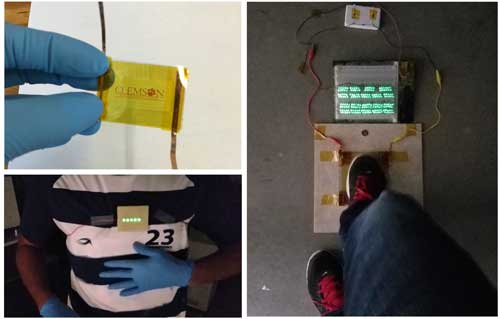| Posted: Apr 12, 2017 | |
A giant leap towards inexpensive and large-scale fabrication of triboelectric nanogenerators for sustainable energy |
|
| (Nanowerk Spotlight) 'Good vibrations', the popular psychedelic hit from the ‘60s, is being interpreted in a very different way by a group of researchers at the Clemson Nanomaterials Institute. With ever-increasing demands for energy, we are faced with challenges to find newer ways to sustainably generate energy. | |
| Notwithstanding the progress in extracting renewable energy from many natural resources through nanotechnologies (read more: "Nanotechnology and energy - a path to a sustainable future"), a Clemson team and 60 other research groups worldwide (see: "Proposed standards for triboelectric nanogenerators could facilitate comparisons") have now begun to develop triboelectric nanogenerators (TENGs) for harvesting energy from “good (mechanical) vibrations” including human walking and ocean waves, which are otherwise wasted. | |
 |
|
| Ultra-simple TENGs (U-TENGs) developed by the Clemson Nanomaterials Institute (left side top panel) can be integrated into textiles (e.g., shirts as shown in the bottom panel on left side) to harvest energy from wind or pedestrians (right side panel). (click on image to enlarge) | |
| TENGs utilize charges arising from friction similar to the static we experience on dry winter days. Going back to the 18th century, Benjamin Franklin found that when a piece of glass and a piece of silk cloth, neither of which exhibit any electrical properties, attract each other after rubbing against each other due to the build up of charges. | |
| In fact, combing your hair with a plastic comb can also build up triboelectricity that allows the comb to attract tiny pieces of paper. This natural affinity for retaining electric charges is pronounced in certain materials, which when integrated in the right combination function as efficient TENGs to generate electricity from mechanical vibrations (e.g., walking and ocean waves) in the surrounding environment. | |
| Nanostructuring the materials in a TENG device amplifies the produced energy by increasing the contact area of the surfaces. The Clemson team found a new way to scalably manufacture large area TENGs with a very high-throughput using off-the-shelf materials. | |
| Their research is published in Nano Energy ("Facile and robust triboelectric nanogenerators assembled using off-the-shelf materials"). | |
| “The standard techniques reported so far to boost the performance of TENG device involve nano/micro-patterning of the electrodes, which is complex, tedious, and expensive,” says Sai Sunil Mallineni, a PhD candidate from Clemson Nanomaterials Institute and the lead author on this Nano Energy paper. “Our TENG design is very simple. Yet, its performance exceeds far beyond other TENGs that require long processing times and tedious lithography.” | |
| The Nano Energy article describes a facile procedure for fabricating devices with tens of cm2 area in less than five minutes with readily available and common materials such as polyethylene terephthalate (PET) and Kapton (polyimide) adhesive tape. | |
| “The market proliferation and large-scale deployment of TENGs for harvesting energy from ocean waves is now possible with our inexpensive and high-throughput fabrication,” hopes Dr. Ramakrishna Podila, Assistant Professor of Physics at Clemson who instigated the study. “We can also integrate them into textiles or staircases for harvesting random mechanical vibrations. We are now endeavoring to make ~m2 area devices to demonstrate practical applications by harvesting energy from ocean waves.” | |
| Herbert Behlow and Yongchang Dong are among the team members from Clemson in addition to Dr. Sriparna Bhattacharya, research assistant professor of Physics at Clemson and Prof. Apparao Rao, Director of the Clemson Nanomaterials Institute. The team is hopeful of transitioning their lab-based results into commercial manufacturing soon. | |
| Provided by Clemson University as a Nanowerk exclusive | |
|
Become a Spotlight guest author! Join our large and growing group of guest contributors. Have you just published a scientific paper or have other exciting developments to share with the nanotechnology community? Here is how to publish on nanowerk.com. |
|
